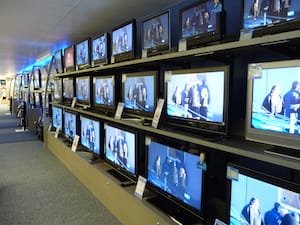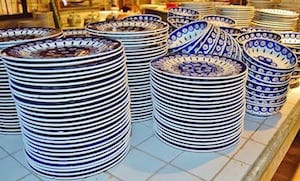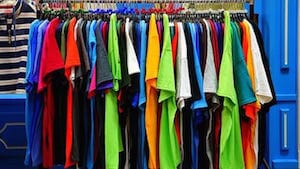
How would you react if you were told you that you had to give up half of your stuff? TVs, clothes, cars, and even dinnerware. Does it sound terrifying? Would you believe me if I told you doing this could make you even happier than you are today?
While our family didn’t do this in one fell swoop, we’ve been trending this direction for the last few years. As I look back, the transformation we’ve made has had a huge impact on our satisfaction with life and there are four big examples that show how we’re becoming twice as happy with half as much.
Example 1: Half the TVs

To get grounded here, lets look at some statistics:
- An American home has, on average, 2.93 TV sets.
- There are 116.2 million households in the US with an average of 2.63 people per household
Fun with math: If every person in the USA was watching TV alone, we’d still have 35 million TVs sitting idle (Tweet this )
It gets better (or maybe worse is a more appropriate term):
- American adults each spend, on average, 5 hours and 4 minutes watching TV a day
- That’s about 35 and a half hours a week
- For men and women of an average life-span, that’s 12.3 years and 13.4 years of their adult life respectively
Is that really how you want to spend 21% of your life?
Our Story
A few years ago, we had 3 TVs - yes, we were bringing up the average :)
When the day was done and the kids were in bed, we’d find ourselves exhausted, turning on the TV and flipping channels until we found something that was agreeable.
Hours later, we’d drag ourselves to bed - still exhausted (though now because we had stayed up late instead of just being tired from a long day), asking ourselves whether what we just watched was actually worth the time.
We promised ourselves that we wouldn’t waste our time like that again, only to slip into old habits a week later.
We never measured, but I’d bet that we spent probably 3 hours a day on average (less on weekdays, more on weekends) watching TV and most of that was time down the drain.
Sure, we’d had some good times bonding over watching some of our favorite shows (Lost, Friends, Saved by the Bell - oh yeah!) but most of what we were watching at this point was junk.
Finally, we bit the bullet and sold two of our TVs in a single month, keeping the smallest one (a 32” with built-in DVD player).
Fast forward a year and we had already significantly cut back on our viewing time, but we still would get into patches where we would zone out in the living room on our lone TV every night for a week.
So we finally did it - we cut the cord. I’m not talking cable (never had it). We cut our antenna.
That’s right. So here’s where we’re at - we own one TV. We have no cable. We have no antenna. We don’t have Netflix or Hulu or Amazon Prime.
Do We Watch Anything?
Yes - we’re just much more selective about what we spend our time watching than we used to be
By cutting the antenna, everything we watch now is a conscious decision
No more mindless “A new show started and I’m too lazy to turn it off”
We chose a small set of network TV shows that both wanted to watch together (about 2 hours a week - all online streaming through the network sites)
In addition, we are loyal fans of Fixer Upper and Tiny House Nation - the only video media we actually pay for
For the kids, we get 1-2 kid-friendly movies once a week from the library (yay free!) and we have about 5 kid movies that we own on DVD. We actually donated most of our DVDs to the library for the same reason - we can still have them when the kids want to watch them, but it’s now a conscious choice - not just “pop in another DVD”.
What We’ve Gained
What we’ve gained here is time - and lots of it. By cutting down from about 3 hours a day to about 3 hours a week (averaged over the year), we are saving ourselves 18 hours per week of time that we can use for other things.
I can honestly say that this blog wouldn’t be here if we hadn’t made that change - this is where a good chunk of my time has been redirected to.
Between that, home improvement projects, and more reading, we’re getting a lot more value and a lot more joy out of our time now than before.
For the next example, we’ll move out of the living room and into the kitchen…
Example 2: Half the Dinnerware

Looking at this forum thread on wedding registries, it looks like most people register for 12 place settings as wedding gifts.
Assuming they get what they ask for, here’s how that all adds up:
- 24 plates (12 salad plates, 12 dinner plates)
- 12 bowls
- 12 coffee cups
- 24 tumblers (12 small, 12 large)
- 12 wine glasses
- 24 forks (12 small, 12 large)
- 24 spoons (12 small, 12 large)
- 12 butter knives
- 12 steak knives
Total: 156 items for one “full set” of dinnerware for the new couple. It’s no wonder most people buy special furniture to hold these items - that’s a whole lot of china!
Some people have multiple sets (formal versus casual, special holiday sets), but we won’t even go there.
On the flip side, here’s how we do it in our household of 5:
- 5 plates (small)
- 5 bowls
- 2 coffee cups
- 3 tumblers (small)
- 5 forks (small)
- 5 spoons (small)
- 5 butter knives
- 5 steak knives
Total: 35 items
We’re well less than half here but in truth we do have a couple extra of the plates, bowls, coffee cups, and tumblers stashed away in case something breaks (which not surprisingly happens about 1-2 times a year with three kids 6 and under). So, giving some fudge factor, we’ll settle for saying we’re a bit better than half of the average household.
Here’s the thinking behind how we choose what to keep in our kitchen cabinets:
How Many Place Settings?
There are only five of us, so we only need five place settings. This might sound oversimplified, but it’s true.
What about the exceptions - birthday parties, having friends or family over?
For these rare instances, we use paper plates and plasticware. The paper plates can get composted and have found some cool compostable silverware as well.
If we were hosting friends or family nightly, it might make sense to get more dishes but we typically only have someone else over for dinner about once a month. Does that seem worth doubling all of our dinnerware?
Talking to a co-worker, he had another option that he’s going to do when he hosts Thanksgiving this year. With his relatives coming from relatively close distances, he’s asking everyone to bring their own dinnerware. It’ll create a cool, eclectic atmosphere with multiple sets at the table, while saving my co-worker from buying unnecessary place settings!
What Sizes to Choose?
You might have noticed that we chose the small plates, forks, spoons, and tumblers. If we were going to consolidate, why’d we choose the “wimpy” ones?
The short answer? Health.
There’s a lot of research out there that shows the correlation between plate size and caloric intake.
In the early 1900’s, the average plate diameter was around 9 inches - that’s a surface area of 63.6 square inches. As of 2010, the average diameter had climbed to 12 inches - a surface area of 113.1 square inches - an increase of 78%!
One study even suggests that switching from a 12-inch plate to a 10-inch plate for a year could lead to a weight loss of 18 pounds for the average adult!
By choosing the smaller plates, we’re more likely to choose appropriate portions and have a healthier waistline. It’s not enough on it’s own, but certainly a step in the right direction!
Forcing Function
Having just one place setting for each family member also helps us keep our kitchen clean. We can’t afford to slack on dishes - if they aren’t clean, we’ve got nothing to eat on!
This means that each meal is followed by a quick wash of whatever we used, which is dried and put away. The whole process takes 10 minutes and we avoid ending up with a full sink of dirty dishes at the end of the day!
With these changes, we’re healthier and more organized - not too shabby!
Our next example is tucked back in the closet…
Example 3: Half the Wardrobe

Here are some interesting clothing stats aggregated on Becoming Minimalist:
- The average American woman owns 30 outfits—one for every day of the month. In 1930, that figure was nine.
- The average American family spends $1,700 on clothes annually.
- While the average American throws away 65 pounds of clothing per year.
While I wasn’t able to get a good answer from the interwebs on what the average wardrobe looks like, I’m pretty sure I’m at less than half of most people.
Take a look and decide for yourself:
For home:
- 4 t-shirts
- 2 long-sleeve shirts (1 hooded sweatshirt, 1 pullover)
- 3 pairs of jeans
- 2 pair of shorts
- 6 pairs of underwear
- 5 pair athletic socks
- 1 pair of pajama pants
- 1 brown belt
- 1 pair of tennis shoes
For work (clothing I wear specifically for my job without double-counting my “for home” items):
- 3 undershirts
- 3 pair dress socks
- 5 dress shirts
- 2 pairs of dress pants
- 1 pair of brown dress shoes
For special occasions:
- 2 ties
- 1 suit coat
- 1 pair of suit pants
- 1 black belt - the dressy kind, not the karate kind :)
- 1 pair of black dress shoes
- 1 pair of tennis shoes for mowing the lawn (so my regular ones don’t get all green)
Total: 46 items
I’ll be honest - that actually ended up being higher than I thought it would. That said, numbers don’t lie and I literally went through and counted everything :)
Here’s the thinking behind how I got to this wardrobe:
Keeping Style
If you’ve been reading this blog, you know that I’m not exactly a fan of fast fashion. That said, I do still want to feel like I look good in the clothes that I wear so I developed a simple strategy.
For any item to become a resident of my closet, I ask, ‘Would I be willing to wear this every day?’ (Tweet this )
What that gets me is a closet full of clothes that I really feel good in. If I had 10 shirts and only really liked five of them, then they’d be the only five I’d wear anyway. By keeping up on laundry, I never needed to wear the less-desirable shirts and so eventually I just got rid of them altogether.
For the limited clothes I’ve got, I never have to question what I “feel like wearing”. Everything in my closet is something that I like and feel good in, so I just grab the nearest items that match and I’m good to go!
Aren’t We Constantly Doing Laundry?
Yes, and that’s a good thing!
With a family of five, we end up doing a load about every day and a half, so I’m constantly in a state where I have fresh, clean clothes despite the relatively small number of clothes on my list.
I’d much rather be doing a single load of laundry every day or so than waiting for it to build up and take care of everything with a full day of doing nothing but laundry. That’s what I did in college. It was excruciating.
Beyond this, you can manage how much laundry you do by remembering that not everything has to be washed after each wear. Underwear, socks, and undershirts do, of course, but you can get by without washing jeans and other items every time you wear them.
You’ll save time, money, and your clothes will last longer.
How Many of Each Item?
This one is a little less strict than the dinnerware example, but my rough goal is to have enough clothing to get through 5 days.
With the mindset above on style and re-wearing some items, this is fairly easy to accomplish without going overboard. I actually have enough clothes to get me further than that, but only because I have some nicer clothes that I can wear for work (when the occasion calls) that I wouldn’t normally wear around the house.
By keeping my quantity of clothes small, so much less of our money is tied up in fabric.
With our wardrobe changes, we are better off financially and get to rely on the fact that our closet is full of stuff we love.
For the last example, lets close with some time in the garage…
Example 4: Half the Cars

Americans own, on average, 0.8 cars per person. In our family, that would translate to 4 cars. Given that only two of us can legally drive, it’s probably reasonable that we would own two :)
Add in the facts that we live in the suburbs and my wife is a stay-at-home mom (she needs to be around when the kids go to and come home from school) and you’ve got a sure-fire argument for a two-car family.
That was us until January 2016 when we sold our Toyota Prius and became a one-car family.
We’re big fans of experimenting before committing to something, so we actually had a “dry run” of being a one-car family in the spring of 2014. We parked our Prius in the garage for 3 months and pretended it didn’t exist so we could see how we’d fare as a busy family of five.
We managed so well that we actually put the car up for sale but didn’t get offers at a price we liked. We took it down and went back to our two-car lifestyle, but held on to the confidence that we could make it with just one if the right opportunity came up.
This January, we had some friends who needed a new car and were hoping to get a used Prius. The situation was perfect, so we transferred the title, cashed the check, and paid off our loan on our minivan.
This was the action that knocked out our second-to-last loan. After this, it’s just the mortgage to go!
More Walking
One of the big enablers to us being able to go down to one car is our proximity to the local school that our kids go to.
With only one car, the default assumption is that every school day is a “walking day” unless weather dictates otherwise. This means that we can’t rely on the car as a backup for late girls in the morning routine.
As a result, we spend a whole lot more time walking - exploring the neighborhood and enjoying the outdoors. On weekends, we even extend this to walking to church as much as we can (though we do still end up driving some of the time based on timing since the walk is so much further).
Time Together
We had an amazing moment one day when my wife and daughters were dropping me off at work. As we pulled up to the building, our oldest daughter commented on all the other cars driving to our building.
“Look, Daddy’s work friends are getting dropped off by their families too,” she said.
We told her that most of the other people I work with drove by themselves, to which she responded.
“That’s really sad. They must get lonely when they drive. Why can’t they ride with their families?”
Clearer than anyone, my daughter saw the blessing that we had - that we got to spend a little extra time together every morning and every afternoon that we rode together. We got to make jokes and talk about what we were excited for in the upcoming day and we got to give hugs and kisses before the busy day started.
Life’s truths are often most visible through the eyes of a child.
Going down to one car gave us more time together, more exercise, and one less loan.
Overall Impact & Takeaways
With these four big changes, we’ve gotten more time to focus on things we enjoy, improved our health, kept organized, saved money and gotten more quality time together as a family.
If you’ve got more stuff than us, remember - this isn’t about judgment. The way we do things works well for us but it might not be right for you. If your extra stuff is bringing you joy, more power to you.
If it isn’t though, maybe it’s time to ask yourself whether you could be happier with less.
As you think about what areas you could cut in half, consider these guidelines to help you get there:
-
Don’t build your life around the ‘what if’ cases”
Don’t stock up on dinnerware for the rare case you host a party of 20 and don’t default to owning two cars for the rare case that you need to drive both at the same time.
Consider what things you own purely for the “what if” scenarios and explore other options for those exceptional cases
-
Create systems to manage better with less
We solved some of the challenges by doing laundry and dishes in smaller batches on a regular basis. Often, people buy extra stuff as a way to enable procrastination. If I have enough underwear, I don’t have to do laundry, right?
Just because you can delay something doesn’t mean that you should.
Remember that doing something more often in smaller chunks doesn’t take any more time than doing it less frequently but all at once. Spending a whole day doing laundry is painful and doing a whole countertop-full of dishes because you’re out of plates is a rough way to start your day.
By being more intentional about when and where you do things, you can keep them manageable so they don’t become the biggest crises of your day.
-
Bet on the feeling of freedom
Every item you claim to own actually owns a little piece of you (Tweet this )
Your time and attention are split in a million different ways and every object in your possession commands a small amount
When you get rid of something, you’re not just opening space in your home - you’re opening space in your mind
Harness this to find the things in your life that don’t bring you happiness but eat up a lot of your attention and figure out how much you can cut

What do you think? What area of your life have you cut to create more happiness? If you don’t have any yet, where could you start?
